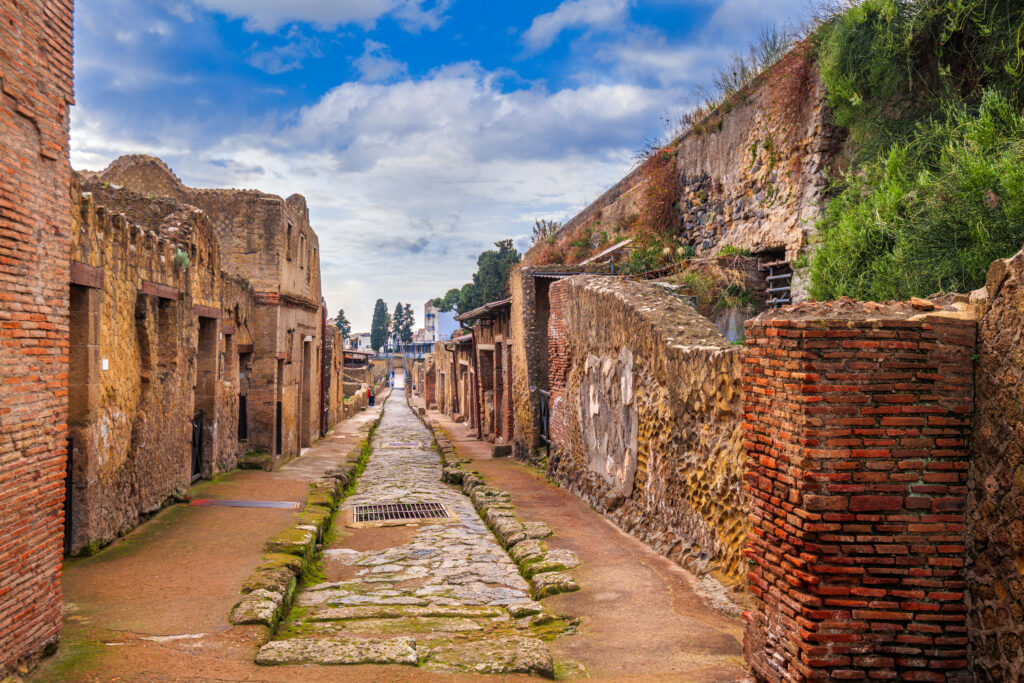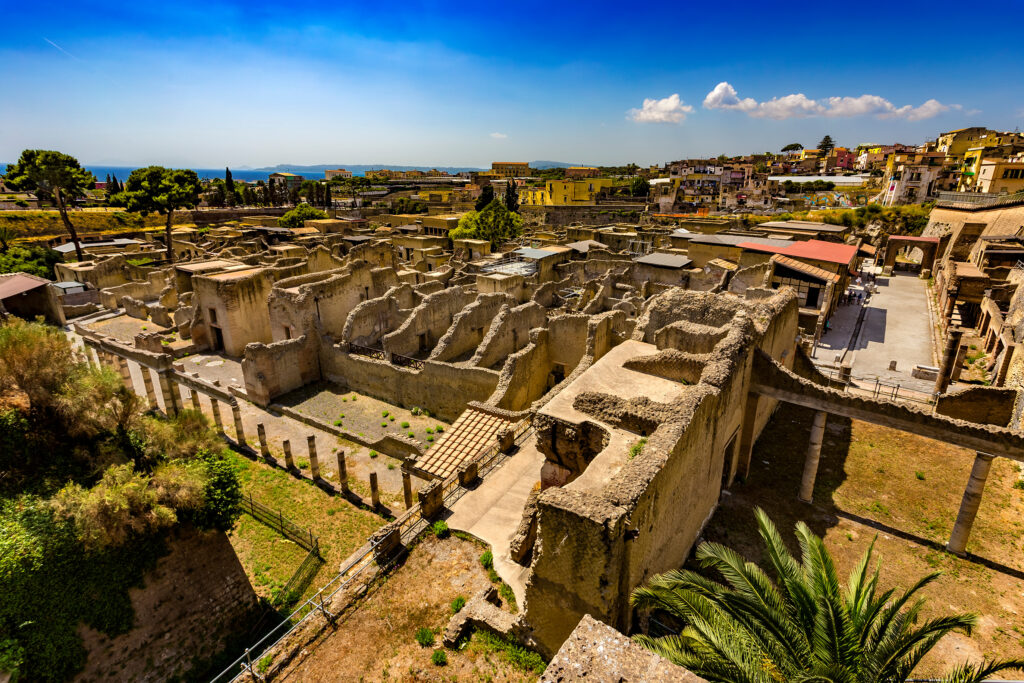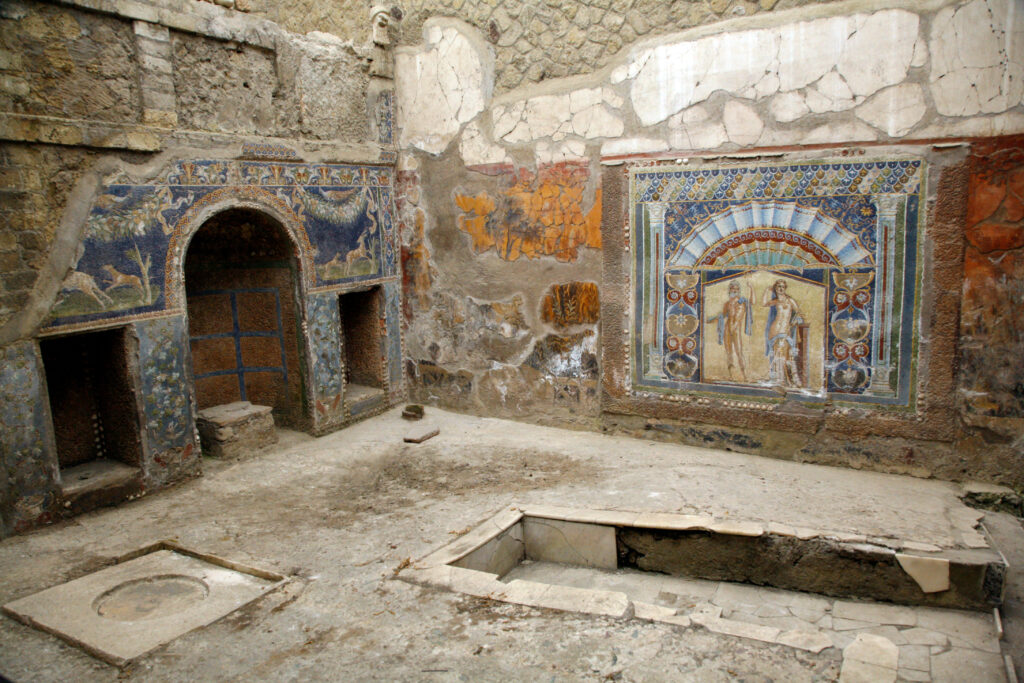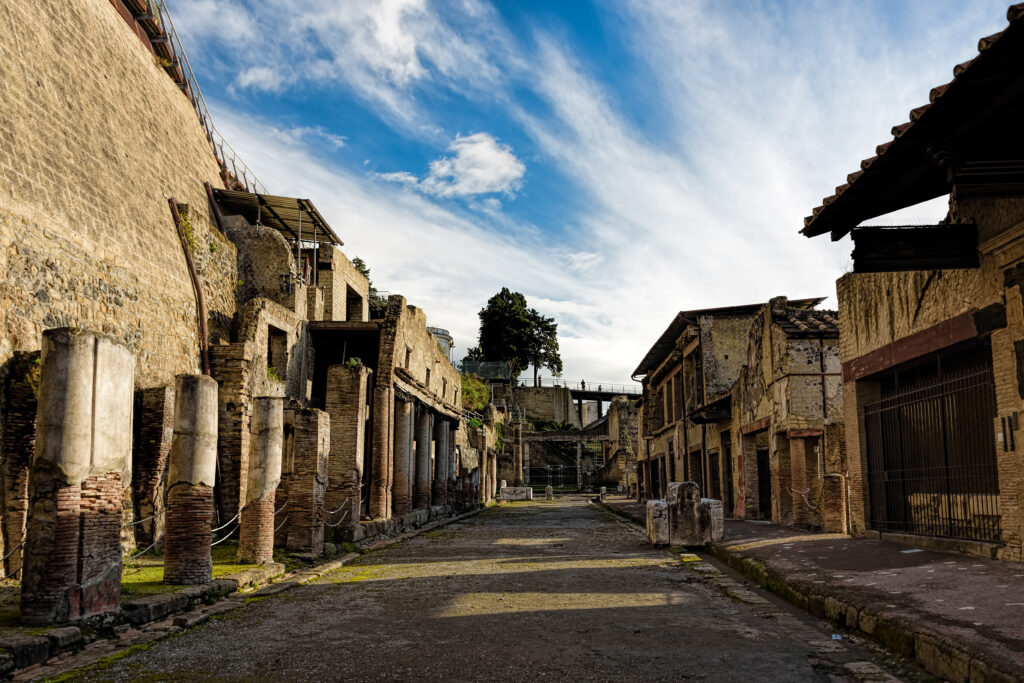
Herculaneum is another Roman village buried by the eruption of Mount Vesuvius in 79 AD, and frozen forever by its ashes. This Roman-era seaside resort is often overshadowed by the much larger Pompeii, so many tourists don't include it in their itinerary.
Yet a visit to Herculaneum is also a must in Italy. Admittedly much smaller than Pompeii, with a surface area of only 4.5 hectares, it is nonetheless extremely rich, and has the merit of being a little more confidential. It also has the advantage of being better preserved, as it was not affected by the eruption in the same way. This makes it even easier to admire its exceptional and sometimes spectacular villas. Herculaneum is home to a villa said to have belonged to Julius Caesar's father-in-law!
If Herculaneum is smaller, it's not because the Roman town was less developed. In fact, a large part of its surface is still buried, simply because a modern town, Ercolano, was built on the new surface. For archaeological reasons, it was not possible to demolish these inhabited buildings, so three-quarters of Herculaneum is still underground.
This is another major difference between Pompeii and Herculaneum: the latter is so close to the Italian city that, from the archaeological site, you can see the modern dwellings towering above us. However, both are UNESCO World Heritage Sites!
How do I get to Herculaneum from Naples?

There are several ways to visit Herculaneum from Naples:
- By train: this is the most convenient and popular way. Simply take the Circumvesuviana train, which circles Vesuvius from Naples. To do this, go to the Napoli Centrale station, where there is a departure every 20 to 30 minutes in high season. Allow 20 minutes for €3.10, then get off at the Ercolano Scavi station.
- With an agency: tourist agencies offer excursions to Herculaneum from Naples. In this case, they usually provide transportation from your hotel, tickets and a guide on site. Some excursions also include a visit to Vesuvius and Pompeii.
- By car: simply take the A3 freeway for around 20 minutes, then leave it at the Portici/Ercolano exit.
What to see and do in Herculaneum

Unlike Pompeii, which is much more extensive and therefore requires you to choose between certain sites, Herculaneum is smaller. It's made up of just 6 streets, so it's possible to visit everything, without planning an itinerary in advance. Don't think you'll get bored, though, as the site is very rich, and most of the houses can be entered.
Don't miss these main monuments when visiting Herculaneum. Although you don't necessarily need an itinerary to visit Herculaneum, we've placed these major sites in the most logical geographical order to discover them:
- The House of Argo: best known for its superb mythological fresco,
- Thermopolia (plural of thermopolium): the Roman equivalent of fast-food restaurants!
- The Skeleton House: named after the human remains found inside,
- The urban thermal baths: admire the pools and their mosaics,
- The sacellum des Augustales: a religious building with a spectacular mythological fresco,
- The black salon house: as its name suggests, this house features a salon with black walls, quite rare in Roman times,
- The Bicentennial House: very spacious,
- The House of Neptune and Amphitrite: owned by a wealthy merchant and decorated with exceptional mosaics,
- La maison du relief de Télèphe: magnificently decorated in red,
- Le Fornici: the name of the Roman port warehouses. This is a major Herculaneum site, as it was here that 300 human skeletons were found trying to escape to the sea when the impressive volcano erupted.
- The Villa of the Papyrus: the most luxurious of Herculaneum's villas, which archaeologists have attributed to Pison, Julius Caesar's father-in-law. Excavations, which are still going on today, so the villa is not always accessible, have uncovered an exceptional heritage, including an extraordinary papyrus library, the only ancient library to have been completely preserved.
On leaving the site, you can also visit the Virtual Archaeological Museum (or MAV), an interactive museum that brings Herculaneum back to life, and projects us into the life of the Romans. Very digital, it's perfect for families.
What are the different options for visiting Herculaneum?

There are several ticket options for visiting Herculaneum:
- The single entry ticket: this simply includes an entrance, a site map and an audioguide, which is very useful as there are no explanatory panels on the site. Click here to book your ticket and take advantage of our partner's special rates.
- Guided tours: several agencies offer tours accompanied by a tour guide or archaeologist. Click here to book your guided tour with an archaeologist!
- Tours including Pompeii and Vesuvius: many agencies offer day tours including Herculaneum, Pompeii and Vesuvius, or just two of the three. These are perfect if you only have a short time to visit the Naples area. Click here to book your day trip to Pompeii, Herculaneum and Vesuvius from Naples: an unforgettable day awaits you!
Practical information you need to know before visiting Herculaneum
Before organizing your stay in the Naples area to visit Herculaneum, make sure you take note of all the practical information.
How long does it take to visit Herculaneum?
Allow around 3 hours, or half a day, to visit Herculaneum.
What are the opening times for the Herculaneum archaeological site?
The Herculaneum archaeological site is open from 9.30 am to 7.30 pm. Please note, however, that the last entrance is at 6 pm. The site is open every day except Wednesday. It is also closed on January1, May1 and December 25.
As for the best time to visit Herculaneum, although it is more confidential than Pompeii, it is also smaller, so the site is very busy fromApril to October. So it's best to visit in mid-season: spring or autumn.
Finally, regarding the time of day, avoid visiting Herculaneum too late, as the site lies at the bottom of an archaeological chasm. In other words, it lies in a hole formed by archaeological excavations and topped by the modern town, so the site is a little dark in the late afternoon, especially in winter.
What equipment do I need to visit Herculaneum?
There are a few essentials to take when visiting Herculaneum:
- Good shoes- even if the ground is more even than Pompeii's, you'll still be walking well,
- Sunscreen, sunglasses and a cap to protect you from the sun,
- A water bottle, to refresh yourself on site,
- A snack, if you feel hungry, as there's no catering service on site.
What to do around Herculaneum
There are many things to do around Herculaneum:
- Naplesnaples, of course, where we recommend you stay to discover it better,
- The Bay of Naples, with its islands like Capri,
- Vesuviuswhich you can even climb to its summit,
- Pompeiione of the world's most fascinating archaeological sites,
- The Amalfi Coast, with its colorful villages,
- Positano, certainly the most famous colorful village on the Amalfi Coast, a very romantic place for a romantic weekend!


